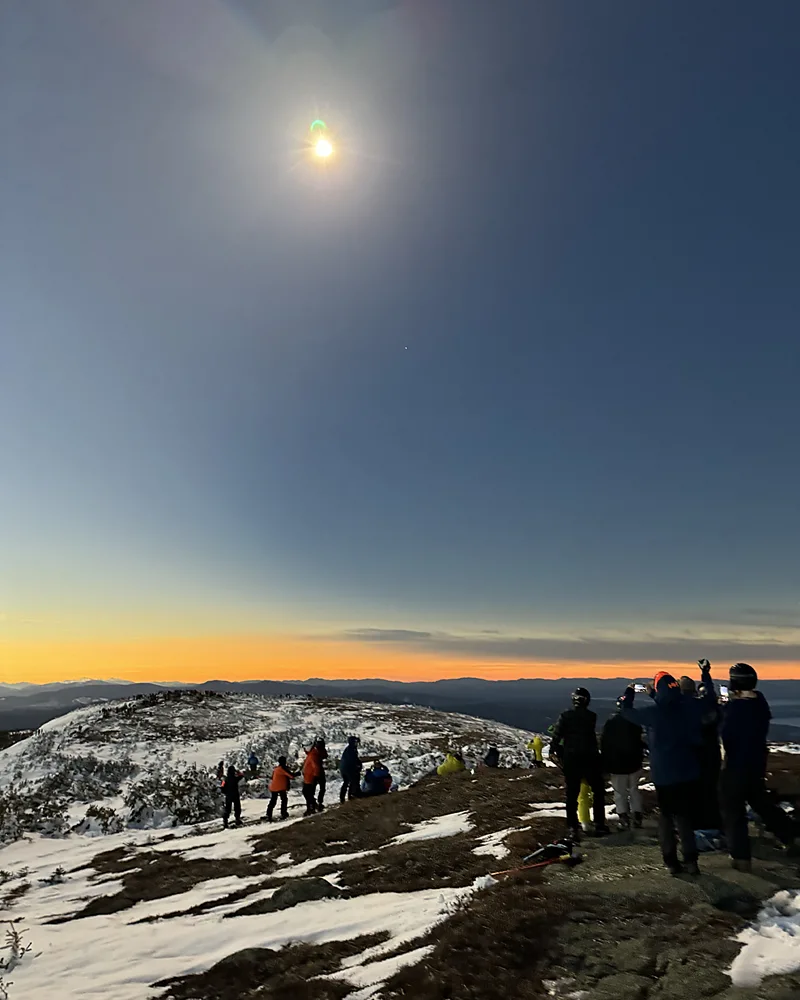The US state where you could ski under the eclipse
 On April 8th, a total eclipse graced the skies, offering a breathtaking spectacle visible from only a select few ski resorts worldwide, including two located in Maine. It was a moment that made one appreciate the gift of being alive. I was fortunate to experience this celestial event on a clear and beautiful day, with temperatures reaching a pleasant 55°F (13°C) atop a mountain in Maine.
On April 8th, a total eclipse graced the skies, offering a breathtaking spectacle visible from only a select few ski resorts worldwide, including two located in Maine. It was a moment that made one appreciate the gift of being alive. I was fortunate to experience this celestial event on a clear and beautiful day, with temperatures reaching a pleasant 55°F (13°C) atop a mountain in Maine.
Adding to the enchantment was a surprise snowstorm just days prior, blanketing the mountain in a fresh layer of pristine snow, perfect for smooth spring skiing beneath the vast expanse of the blue sky.
I embarked on a journey deep into the heart of Maine, the most densely forested and rural state in the country, approximately three hours northwest of my home in Portland, to witness these fleeting three minutes and 27 seconds of celestial wonder. Joining me were countless others who had traveled from across the nation, perhaps passing by the Moon's largest meteorite on display at the Portland International Jetport as a nod to the eclipse.
Saddleback and Sugarloaf ski resorts, nestled deep within the woods of Maine, were among the few ski areas in the United States, all located in the eastern region, where one could witness the total eclipse. These celestial mountains and lakes, once lauded by Henry David Thoreau, who famously sought to "live deliberately" in Maine's wilderness, offer a year-round haven for outdoor enthusiasts. Whether it's hiking, fly fishing, camping, or stargazing, these woods provide endless opportunities for exploration and appreciation of nature's wonders.
Skiing in this region represents the freedom to immerse oneself in the natural world, and on April 8th, this playground expanded far beyond earthly boundaries, reaching into the vastness of the solar system. It served as a poignant reminder not to take anything for granted on this planet, urging us to cherish and respect the beauty and mysteries of our surroundings. Reaching the summit of Saddleback Mountain was a rewarding feat, especially considering the effort required to witness the remarkable alignment of the Sun and Moon. After dismounting from the Kennebago Quad chairlift and hiking another half-mile, I joined a group of skiers and snowboarders ascending the mountain's slopes. We traversed the iconic Appalachian Trail, a hiking-only footpath spanning 14 states, to reach an elevation of 4,120 feet.
Reaching the summit of Saddleback Mountain was a rewarding feat, especially considering the effort required to witness the remarkable alignment of the Sun and Moon. After dismounting from the Kennebago Quad chairlift and hiking another half-mile, I joined a group of skiers and snowboarders ascending the mountain's slopes. We traversed the iconic Appalachian Trail, a hiking-only footpath spanning 14 states, to reach an elevation of 4,120 feet.
Upon reaching the summit, I found myself surrounded by fellow outdoor enthusiasts, some building snowmen while others set up camp chairs. None of us were prepared for the breathtaking display of the golden hour typically seen before sunset.
The Sun's radiant beams illuminated the snow-covered landscape, casting a brilliant glow over the surrounding lakes and mountain peaks. As the Moon, significantly smaller yet much closer to Earth than the Sun, passed between the two celestial bodies, it created a captivating shadow that enveloped us. This celestial event united our small community of skiers with the vastness of life on Earth, reminding us of our connection to the cosmos. Given that the next eclipse over Maine is not expected until 2079, experiencing this rare event while skiing was truly a once-in-a-lifetime opportunity. Matthew Walter, a skier at Sugarloaf Mountain ski resort, seized the moment by timing his ski run to coincide with the eclipse.
Given that the next eclipse over Maine is not expected until 2079, experiencing this rare event while skiing was truly a once-in-a-lifetime opportunity. Matthew Walter, a skier at Sugarloaf Mountain ski resort, seized the moment by timing his ski run to coincide with the eclipse.
He described how the faint light filtering through the solar corona shimmered across the snow, creating unique shadows that added an unexpected challenge to his descent. Despite the temptation to continuously gaze at the spectacle above, Walter noted the overwhelming sense of significance that permeated the atmosphere, even without directly observing the eclipse. As I observed, the sky transitioned rapidly from daylight to a deep darkness reminiscent of nightfall, followed by hues of orange and pink reminiscent of dawn. It felt as though the sun had dipped below the horizon, casting an eerie atmosphere over the summit. A chilling wind swept across the landscape, causing the temperature to plummet by 10 degrees Fahrenheit in a matter of seconds, creating optimal conditions for a refreshing final ski run.
As I observed, the sky transitioned rapidly from daylight to a deep darkness reminiscent of nightfall, followed by hues of orange and pink reminiscent of dawn. It felt as though the sun had dipped below the horizon, casting an eerie atmosphere over the summit. A chilling wind swept across the landscape, causing the temperature to plummet by 10 degrees Fahrenheit in a matter of seconds, creating optimal conditions for a refreshing final ski run.
Reflecting on the experience, a member of the Appalachian Trail Club drew attention to the delicate alpine flora emerging amidst the rocks and snow. This prompted contemplation about how ancient Indigenous peoples might have perceived such celestial phenomena in the absence of modern scientific understanding. It evoked a sense of awe and reverence for the mysteries of nature and the cosmos, highlighting the profound impact such occurrences may have had on early civilizations.














































